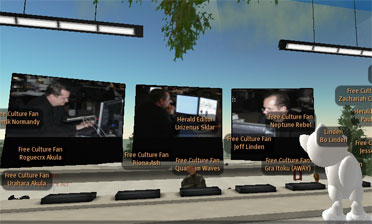
As Ben has reported, the Economics of Open Content conference spent a good deal of time discussing issues of copyright and fair use. During a presentation, David Pierce from Copyright Services noted that the major media companies are mainly concerned about protecting their most valuable assets. The obvious example is Disney’s extreme vested interest in protecting the Mickey Mouse, now 78 years old, from entering the public domain. Further, Pierce mentioned that these media companies fight to extend the copyright protection of everything they own in order to protect their most valuable assets. Finally, he stated that only a small portions of their total film libraries are available to consumers. Many people in attendance were intrigued by these ideas, including myself and Paul Courant from the University of Michigan. Earlier in the conference, Courant explained that 90-95% of UM’s library is out of print, and presumably much of that is under copyright protection.
If this situation is true, then, staggering amounts of media are being kept from the public domain or are closed from licensing for little or no reason. A little further thinking quickly leads to alternative structures of copyright that would move media into the public domain or at the least increase its availability, while appeasing the media conglomerates economic concerns.
Rules controlling the protection of assets is nothing new. For instance, in US professional sports, fairly elaborate structures are in place determine how players can be traded. Common sense dictates that teams cannot stockpile players from other teams. In the free agency era of the National Football League, teams have limited rights to control players from signing with other teams. Each NFL team can designate a single athlete as a “franchise” player, according to the current Collecting Bargaining Agreement with the player union. This designation gives them exclusive rights in retaining their player from competing offers. Similarly, in the National Basketball Association, when the league adds a new team, existing teams are allowed to protect eight players from being drafted and signed from the expansion team(s). What can we learn from these institutions? The examples show hoarding players is not good for sports, similarly hoarding assets is not in the best interest of the public good either.
The sports example has obviously limitations. In the NBA, team rosters are limited to fifteen players. On the other hand, a media company can hold an unlimited number of assets. In turn, applying this model would allow companies to seek extensions to only a portion of their copyright assets. Defining this proportion would certainly be difficult. For instance, it is still unclear to me how this might adapt to owners of one copyrighted property.
Another variant interpretation of this model would be to move the burden of responsibility back to the copyright holder. Here, copyright holders must show active economic use and value from these properties. This strategy would force media companies to make their archives available or put the media into the public domain. These copyright holders need to overcome their fears of flooding the markets and dated claims of limited shelf space, which are simply not relevant in the digital media / e-commerce age. Further, media companies would be encouraged to license their holdings for derivatives works, which would in fact lead to more profits. In that, these implementations would increase revenue by challenging the current shortsighted marketing decisions which fail to account for the long tail economic value of their holdings. Although these materials would not enter the public domain, they would be become accessible.
Would this block innovation? Creators of content will still be able to profit from their work for decades. When limited copyright did exist in its original implementation, creative innovation was certainly not hindered. Therefore, the argument that limiting protection of all of a media company’s assets in perpetuity would slow innovation is baseless. By the end of the current time copyright period, holders have ample time to extract value from those assets. In fact, infinite copyright protection slows innovation by removing incentives to create new intellectual property.
Finally, few last comments are worth noting. These models are, at best, compromises. I present them because the current state of copyright protection and extensions seems headed towards former Motion Pictures Association of America President Jack Valenti’s now infamous suggestion of extending copyright to “forever less a day.” Although these media companies have a huge financial stake in controlling these copyrights, I cannot overemphasize our Constitutional right to place these materials in the public domain. Article I, Section 8, clause 8 of the United States Constitution states:
Congress has the power to promote the Progress of Science and useful Arts, by securing for limited Times to Authors and Inventors the exclusive Rights to their respective Writings and Discoveries.
Under these proposed schemes, fair use becomes even more cruical. Conceding that the extraordinary preciousness of intellectual property as Mickey Mouse and Bugs Bunny supersedes rights found in our Constitution implies a similarly extraordinary importance of these properties to our culture and society. Thus, democratic access to these properties for use in education and critical discourse must be equally imperative to the progress of culture and society. In the end, the choice, as a society, is ours. We do not need to concede anything.

